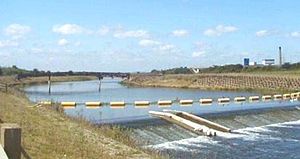This is an old revision of this page, as edited by 94.192.111.234 (talk) at 18:29, 19 December 2010. The present address (URL) is a permanent link to this revision, which may differ significantly from the current revision.
Revision as of 18:29, 19 December 2010 by 94.192.111.234 (talk)(diff) ← Previous revision | Latest revision (diff) | Newer revision → (diff)
The Jubilee River is a hydraulic channel in southern England. It is 11.6 km (7.2 mi) in length and is on average 45 metres (148 ft) wide. It was constructed in the late 1990s and early 2000s to take overflow from the River Thames and so alleviate flooding to areas in and around the towns of Maidenhead, Windsor, and Eton in the counties of Berkshire and Buckinghamshire. It achieves this by allowing excess water to be taken via the east bank of the Thames upstream of Boulter's Lock near Maidenhead and returned via the north-east bank downstream of Eton.
The Environment Agency commissioned the design and construction of the river which cost £110 million. When it was formed, the channel was the largest man-made river project ever undertaken in Britain, and the second largest in Europe. As well as creating the channel and its various flow control mechanisms, the scheme involved constructing many bridges for road, rail and foot traffic. One of these, Dorney Bridge, involved taking the river through a nineteenth-century Brunel railway embankment while it continued to carry main line trains between London and Bristol. This delicate work to infrastructure considerably more than a century old was achieved by freezing the embankment, boring through it and then inserting a preformed concrete culvert.

A further requirement was to take the river through Black Potts Viaduct, another Victorian structure that is part of the railway line built to take Queen Victoria's royal train almost up to the gates of Windsor Castle. This work called for substantial protective structures to be put in place in order to preserve the structural integrity of the viaduct.
The new river is a highly complex civil engineering accomplishment that involved many technical, ecological and social issues, including extensive compulsory purchases, community involvement and a public enquiry. Conception to fruition took about twenty years.
However, considerable defects in the engineering were exposed in January 2003, when the first serious use of the channel was needed during a major flood. Even though the channel operated well short of the flow capacity that it was designed to take, weir failure and substantial bed and bank erosion still happened. These issues resulted in a substantial programme of repair and associated upgrading, costing about £3.5 million. The Environment Agency sued the lead design consultants for recovery of those remedial costs, and an out-of-court settlement of £2.75 million was agreed.

The choice of a name for the river was put to the local population in the form of a poll. The result was a strong preference for 'Jubilee', as it was being completed in Queen Elizabeth's golden jubilee year of 2002 and as Her Majesty's preferred home is at Windsor Castle, in one of the three towns being protected by the scheme.
Despite being man-made, the Jubilee River looks and acts like a natural river. Its banks have artificially constructed wildlife habitats intended to replace those lost from the banks of the Thames during urban expansion in the nineteenth and twentieth centuries. During construction 38 hectares (94 acres) of reed beds and 5 hectares (12 acres) of wet woodland were laid down and about 250,000 trees were planted.
The river is well used by walkers, runners, wildlife enthusiasts and cyclists alike, as a combined footpath with National Cycle Route 61 runs along virtually its entire length. A wide variety of bird-life can be seen along the river, with green woodpeckers, cormorants, peewits and red kites among the more interesting examples of ornithology visible.
See also
References
- "Windsor & Eton Self Guided Walk Stage 4- Victoria Bridge to Jubilee River". Travellers Toolkit. Retrieved 21 March 2010.
- ^ C. W. Nicol (2 July 2008). "The right way to reconstruct rivers". The Japan Times online. The Japan Times Ltd. Retrieved 20 April 2010.
- Environment Agency - A map indicating the location and route of the Jubilee River
- Charles Clover, Telegraph Environment Editor Flood maps show extra 300,000 homes are now at risk 07 Oct 2004
- HR Wallingford Jubilee River - Black Potts viaduct and Pococks Lane bridge
- Royal Windsor Web Site January 2003 Floods and Jubilee River Bank Collapse
- New Civil Engineer Plus EA sues designers of failed Jubilee River flood defence EMAP Construct 15 June 2006
- New Civil Engineer Plus News EMAP Construct 14 September 2006
- UK RIvers Guide Book Guide to the RIver Thames - Jubilee River
External links
- Discussions and articles relating to the Jubilee River
- Information on the Jubilee River and the floods of 2003
- Information about the habitat of the Jubilee River
- National Cycle Network Route 61 along the Jubilee River
| Next confluence upstream | River Thames | Next confluence downstream |
| Clewer Mill Stream (south) | Jubilee River | Colne Brook (north) |
| Non-tributaries | |
|---|---|
| Tributaries | |
| Passing Denham/Iver |
|
| Man-made | |
51°29′27″N 0°35′35″W / 51.4907°N 0.5931°W / 51.4907; -0.5931
Categories: